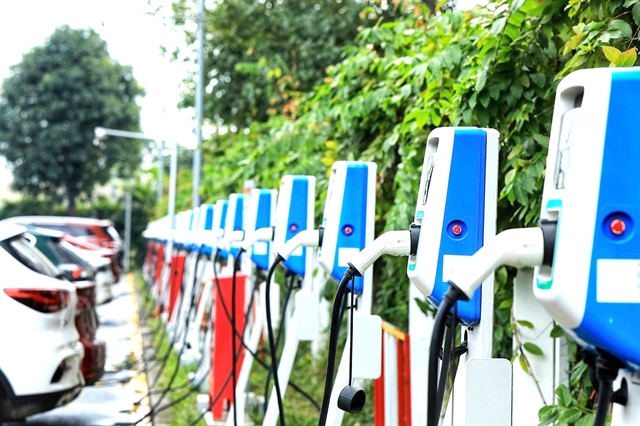Despite having rich mineral resources crucial for battery manufacturing, Vietnam still relies on foreign raw material supplies and has limited production capacity, which puts it at a disadvantage when it comes to meeting global demand.

An electric vehicle charging station in Hà Nội. Energy storage systems and tools such as batteries play an important role in Việt Nam's energy transition process. — VNA/VNS Photo Tuấn Anh
Vietnam has the potential to become an important link in the global battery supply chain due to its rich mineral resources, but much more effort is needed in the research and development of domestic battery production to fully realise this potential.
Việt Nam has abundant sources of minerals such as nickel, cobalt and rare earths, which are often used to produce batteries for electric vehicles, computers, and smartphones.
The country has also set ambitious goals for energy transition. The National Power Development Plan VIII recently approved by the Prime Minister has a strong focus on developing renewable energy sources for electricity generation, with a target of having around 30.9-39.2 per cent of electricity produced from renewable energy by 2030.
This is an effort to reach the target of 47 per cent of renewable electricity by 2030, and 67.5-71.5 per cent by 2050, which were the goals specified in the Joint Statement on the Just Energy Transition Partnership (JETP) that Việt Nam signed with international partners.
Policies to develop energy storage systems have also been introduced. For example, the Law on Electricity encourages investments in wind and solar power projects combined with energy storage, provides financial support to households installing rooftop solar panels and energy storage, and it provides incentives for individuals and companies that can develop energy storage systems domestically.
However, despite its potential and existing favourable policies, Việt Nam's battery supply chain is still in its early stages and faces many challenges. These include limited production capacity, increasing international competition, and the need for more refined supporting policies.
The country's dependence on foreign raw material supplies also signals an urgent need to build a stronger and more flexible domestic battery supply chain.
High global battery demand
According to Lê Tuấn Anh, director of the Department of Industrial Economy and Service Economy (under the Ministry of Planning and Investment): "We are witnessing a strong shift in the global energy sector, with lithium-ion batteries playing a central role in the development of electric vehicles and battery energy storage systems."
He made the statement at a workshop on enhancing the battery supply chain in Việt Nam's energy transition process, held last week in Hà Nội by the Southeast Asia Energy Transition Partnership of the United Nations Office for Project Services (UNOPS).
Citing a report from the International Energy Agency (IEA) released in December 2024, Tuấn Anh said that the global demand for batteries is expected to increase 4.5 times by 2030 and more than seven times by 2035.
Global battery capacity in 2023 reached about 850 gigawatt hours (GWh), up more than 40 per cent compared to 2022, with electric vehicles (EV) being the main driver of the battery market.
The demand for EV batteries accounted for around 750 GWh – or nearly 90 per cent – of the total battery demand in 2023. China was the largest battery market that year, representing about 55 per cent of global demand.
Lê Tuấn Anh, director of the Department of Industrial Economy and Service Economy under the Ministry of Planning and Investment speaks at the workshop in Hà Nội last week. — VNA/VNS Photo Tuấn Anh
According to Dr Đinh Công Hoàng from the Vietnam Academy of Social Sciences, with significant nickel reserves in the northern province of Sơn La, Vietnam is emerging as a key player in the global electric vehicle supply chain, especially in providing raw materials and manufacturing EV batteries.
"To realise this potential, sustainable development strategies need to be implemented," he said. "For example, raw material sources should be diversified through international cooperation to ensure supply stability while allowing Việt Nam to access advanced mining and processing technologies. Domestic supply should also be developed through exploitation of domestic mineral mines."
He added that more resources should be allocated to research and development (R&D) activities so that Việt Nam can develop its own battery manufacturing technology.
"Specialised battery technology research centres should be developed," he said. "Research institutes and universities should collaborate to develop advanced, high-performance, and environmentally friendly battery solutions.
"We should also collaborate with international companies to adopt and localise modern battery manufacturing technology, improving the quality of our own batteries and reducing production costs."
Learning from international experiences
Referencing Australia's experience, Professor Aruna Ranaweera from Kelaniya University, Sri Lanka, said that Australia supports the battery industry through government funds and strategic initiatives like the Australian Renewable Energy Agency, the Capacity Investment Scheme, and the National Battery Strategy.
The country has also updated its list of critical minerals to attract investment in battery-related minerals, which is supported by the National Reconstruction Fund and the Northern Australia Infrastructure Facility.
It has allocated hundreds of millions of dollars for a domestic battery manufacturing plan, and established bilateral agreements with the US, Singapore, India, Japan, South Korea, France and Germany in critical minerals and renewable energy development.
In India, the discovery of lithium reserves in Jharkhand and Rajasthan has made the country more self-sufficient in battery production. Using the Viability Gap Funding mechanism in public-private partnerships has helped bridge the financial gap between a project's overall cost and expected revenue, and hasboosted investment. India has also set energy storage goals for each state, such as 10 GWh in Rajasthan by 2030.
Ranaweera said: "Focusing on identifying and developing domestic critical mineral sources could help Việt Nam reduce its reliance on imports and strengthen the domestic battery supply chain. Developing domestic reserves not only enhances self-sufficiency but also strengthens Việt Nam's position in the global battery market." — VNS
Read original article here